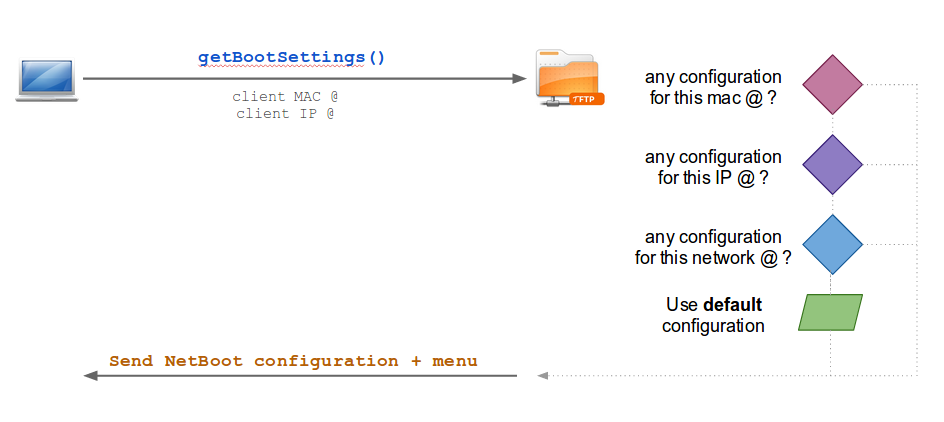TFTP server manage netboot kernels
Contents
TFTP configuration
TFTP can manage different configurations, up to 1 per host!
This is how a ThinClient (= netBoot client) will retrieve its configuration:
As you can see you have 3 possibilities:
1. MAC @ filter. Configuration file name must be:
- Start with ARP type '01-'
- all in lower case hexadecimal
- dash '-' separators instead of ';'
for example a MAC @ 88:99:AA:BB:CC:DD would search for the filename 01-88-99-aa-bb-cc-dd.
2. IP @ filter. Configuration file name must be:
- host IP / network address in hexadecimal
- all in upper case
e.g. 192.0.2.91 -> C000025B
3. Default configuration
To learn more about all the available option, check out http://www.syslinux.org/wiki/index.php/PXELINUX.
The first thing to do is to setup a booting kernel. To do so we'll use the "syslinux" files.
Reminder
If your client(s) will use some smart-cards driver then you MUST install these drivers on the on the NFS server + reboot the server ; before going through the following steps. See Drivers#Smart-card_drivers
Now, we have to specify which kernel to use and which distributions are available for NetBoot.
Create the default configuration file:
vim /tftpboot/pxelinux.cfg/default
Put the following:
# Debian 7.x
LABEL wheezy
kernel images/wheezy/vmlinuz
initrd images/wheezy/initrd.img
# Ubuntu 14.04
LABEL trusty
kernel images/trusty/vmlinuz
initrd images/trusty/initrd.img
# Prompt user for selection
PROMPT 1
# No timeout
TIMEOUT 0- Each LABEL is a specific configuration that will displayed on the NetBoot menu.
- PROMPT 0 = enable user prompt so you can choose the configuration
- TIMEOUT 0 = timeout (in seconds) before the default option is chosen. 0 == no timeout
Note that I used a reference to "trusty/", that's a folder I need to create later on.
Init Kernel files
Create directories
Create the target kernel folders. You should create 1 folder for each distribution you'd like to provide in NetBoot.
# Debian 7.x
mkdir -p /tftpboot/images/wheezy
# Ubuntu 14.04
mkdir -p /tftpboot/images/trusty
Prepare initramfs to boot over NFS
This step must to be run on the machine that has the kernel you are going to serve to your clients.
>>> In our case it has to be run on the TFTP server
Copy initramfs settings for PXE boot
cp -r /etc/initramfs-tools /etc/initramfs-pxe
Adjust PXE boot configuration
cd /etc/initramfs-pxe/
vim /etc/initramfs-pxe/initramfs.conf
Add / adjust the following options:
BOOT=nfs
MODULE=netboot
Copy and prepare kernel
You have to copy your current kernel files to the boot folder:
# Debian 7.x
cp /boot/vmlinuz-`uname -r` /tftpboot/images/wheezy/vmlinuz
cp /boot/initrd.img-`uname -r` /tftpboot/images/wheezy/initrd.img
# Ubuntu 14.04
cp /boot/vmlinuz-`uname -r` /tftpboot/images/trusty/vmlinuz
cp /boot/initrd.img-`uname -r` /tftpboot/images/trusty/initrd.img
Enable NFS boot on target kernel:
mkinitramfs -d /etc/initramfs-pxe -o /tftpboot/images/trusty/initrd.img
Adjust rights:
chmod -R 755 /tftpboot/images/
Notes:
- Do NOT use some symlink for "vmlinuz" and "initrd.img" !! It won't work.
- If you don't want to use `uname -r` [current kernel version and architecture] then adjust the values to target kernel number + architecture
- You have to run mkinitramfs for each kernel you'll provide
- Don't forget to adjust the rights to 755 for every distribution
